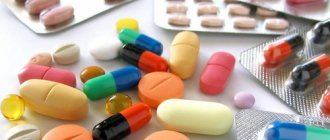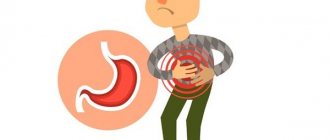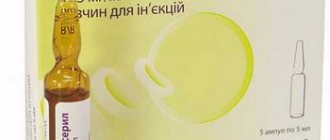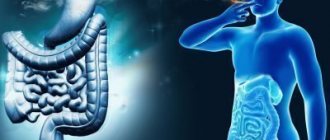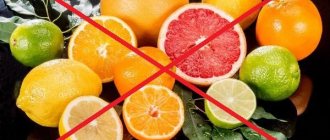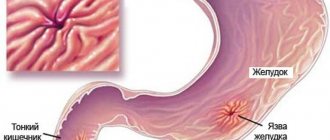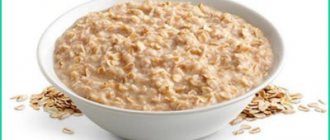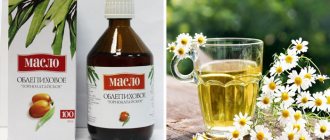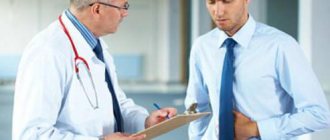If a bleeding ulcer of the stomach or duodenum has opened, then immediate medical attention to the patient is required. This complication of peptic ulcer disease is manifested by severe pain, dark-colored vomit and tarry feces. A complicated form of bleeding ulcer requires emergency gastric surgery. With minor blood loss, it is possible to manage with conservative therapeutic measures.
Causes
People with cardiovascular diseases, diabetes and other pathologies are at risk. Bleeding from an ulcer is observed in those who previously suffered from a peptic ulcer of the digestive system. The main causes of the problem also include:
- Chemical and mechanical damage to the walls of the organ.
- Neoplasms.
- Microcirculation disorder.
- Atherosclerosis or thrombosis.
- Low level of platelets in the blood.
- Uncontrolled use of certain groups of drugs.
If the patient has previously been diagnosed with an ulcer, the following can lead to rebleeding:
- bad habits;
- poor nutrition;
- stress;
- heavy physical activity;
- inflammatory processes in the affected area.
Prevention
If you have a peptic ulcer, you need to follow a very gentle diet. You need to take food that will support the vital functions of the body and at the same time not irritate the ulcer already existing in the stomach. Food should be pureed and pureed.
It is prohibited to drink alcohol. You can eat cottage cheese soufflé, vegetable soups, pureed porridge, meat and fish should be steamed, mashed potatoes and jelly are allowed. The diet can be agreed upon with the attending physician, who will recommend one or another food that is not harmful in a particular case.
Such patients are prohibited from eating spicy, salty, or fatty foods. Perforation can be provoked by physical activity; lifting heavy objects can cause a rupture, since at this moment abdominal pressure increases. From a blow, or if a person falls where the thinnest part of the ulcer is, a rupture may occur.
Symptoms
With minor blood loss, signs appear to a minor extent or may be completely absent. As bleeding increases, a person may notice:
Important information: What to do and how to stop bleeding with an ovarian cyst (polycystic disease)
- pain in the affected area;
- vomit containing blood;
- shortness of breath;
- dark-colored stool.
Symptoms of bleeding from a stomach or duodenal ulcer depend on the degree of blood loss:
- If the patient has lost no more than 5% of blood, the pressure is within normal limits. There may be a slight increase in heart rate. The patient does not feel discomfort.
- With blood loss of no more than 15%, a person experiences weakness. Tachycardia appears. The pressure drops to 90 mm Hg. Art. The patient should not get out of bed unless necessary: fainting is possible.
- When the patient loses 30% of his blood, he is in serious condition. A sign of ulcerative bleeding is paleness of the mucous membranes and skin. The pulse is practically not palpable. The pressure drops to 60 mmHg. Art.
- If a bleeding ulcer has resulted in a loss of more than 30% of blood, the patient's condition becomes extremely serious. The pulse cannot be felt. In some cases, patients fall into a coma.
Diet for an open ulcer
One of the components of effective therapy is nutrition, which involves the strictest restrictions. A diet for a bleeding stomach ulcer involves an absolute refusal of liquid and food on the first day. If there is severe thirst, the patient is given water (several teaspoons) or ice to suck. Subsequent meals include raw eggs, milk, jelly, and liquid jelly.
Experts have come to the conclusion that if there is an open process with bleeding, prolonged hunger is contraindicated, since the secreted gastric juice worsens the condition of the mucous membrane. The body must receive the required number of calories, mineral salts, vitamins, and proteins. In this case, the food should be liquid.
Therapy for peptic ulcer disease includes following a diet
What diet should you follow in the following days? A little later, you can add a soufflé of cottage cheese, meat, vegetable purees, crushed cereals, steamed cutlets, and butter to your diet. When a patient has an ulcer and starts bleeding, all spicy foods, alcoholic drinks, smoked foods, and fried foods are completely prohibited.
Treatment
A stomach ulcer with bleeding should be a reason to immediately consult a doctor. Before the ambulance arrives, the patient or his relatives must provide first aid. Taking medications and performing gastric lavage is strictly prohibited. A doctor should prescribe hemostatic drugs.
In addition to medications, specialists use surgical intervention and mechanical methods to stop bleeding - gluing damaged mucous membranes, doping, applying clips. For large blood losses, a blood transfusion may be prescribed.
First aid
First aid for bleeding ulcers of the duodenum and stomach is similar to the actions that are performed for other internal bleeding:
- The patient must be placed on a hard, flat surface. To help the brain avoid oxygen starvation, you should place a cushion (from pillows, folded clothes) under the patient’s legs. This will cause a rush of blood to the head.
- Physical activity is not allowed. The patient should avoid unnecessary movements.
- It is forbidden to give food and drinks to the patient, even if he is very hungry or thirsty. It is acceptable to apply a heating pad with ice or cold water to your stomach. Every 10 minutes the heating pad must be removed for a few minutes. Cold can cause blood vessels to constrict and reduce or completely stop bleeding.
- The patient must be kept conscious until the doctor arrives. You should constantly talk to the patient and ask him to tell you something. If the patient loses consciousness, you need to let him smell cotton wool soaked in ammonia.
Important information: How to stop breakthrough uterine withdrawal bleeding when taking birth control pills (drugs) and why it bleeds
Drug therapy
To treat the stomach and duodenum, the patient may be prescribed:
- Vikasol. The product replenishes the lack of platelets and normalizes blood clotting. Vikasol is used not only in cases where the patient is diagnosed with a bleeding ulcer, but for the prevention of pathology.
- Atropine. The medicine stops bleeding and promotes the regeneration of damaged tissue.
- Aminocaproic acid. The remedy is one of the most common ways to stop bleeding. The acid acts on blood vessels, causing them to constrict, and accelerates blood clotting. In addition, the medicine cleanses the liver of toxins. Aminocaproic acid not only does not provoke allergies, but is also often used to suppress some specific negative reactions.
Operation
Surgical intervention for bleeding from gastric and duodenal ulcers is resorted to in case of large blood loss in the patient. Depending on the location of the affected area, the doctor may choose vascular suturing, excision, resection or suturing.
Folk remedies
If a patient has a bleeding stomach or duodenal ulcer, it is impossible to stop the bleeding with folk remedies. However, alternative medicine can be used as an additional treatment after the patient is discharged from the hospital to go home. Traditional medicine uses:
- Juices. 1-2 times a day, 30-40 minutes before meals, the patient should take ½ glass of freshly squeezed carrot, potato, pumpkin or cabbage juice. This medicine has almost no contraindications and promotes healing.
- Bee products. Open ulcers of the stomach and duodenum are in most cases treated with infusions of honey and propolis, which are highly effective. However, you can resort to such medications only after receiving a doctor’s approval. Bee products can cause an allergic reaction.
- Medicinal plants. You can speed up healing with a decoction of calendula, rose hips and flax seeds. It is necessary to mix these plants in equal proportions, and then brew 1 tsp. collection with 1 glass of boiling water. The drink is infused for 40-60 minutes and consumed half a glass between meals. To prepare the infusion, it is permissible to use only dried medicinal plants.
- Oil. For duodenal or stomach ulcers, it is recommended to take olive or sea buckthorn oil. The medicine is added to salads or consumed on an empty stomach, 1 tbsp. l. 40 minutes before meals.
Important information: Bleeding from the esophagus in liver cirrhosis (hepatic) and what are its symptoms
The course of treatment with folk remedies lasts from 10 to 30 days. Then you should take a break for 3-4 weeks.
Proper nutrition
To prevent gastric bleeding from recurring after discharge from the hospital, you must follow a diet. The patient is recommended:
- Semi-liquid porridge (rice, semolina or oatmeal). You can cook porridge with water or milk. Add 1 tsp to the finished dish. vegetable oil.
- Low fat dairy products.
- Lean meats and fish. You can cook dishes or cook broths from them.
- Sweet berries and fruits.
- Vegetables. Desirable methods of preparing vegetables are boiling or stewing.
- Eggs. You can prepare an omelet or soft-boil the product.
- Weak tea, still mineral water.
Bleeding from an ulcer in the duodenum or stomach can be caused by foods that irritate the mucous membrane of the digestive tract, such as hot sauces. If an ulcer is open, you should avoid foods that require a long time to digest - smoked sausages, fatty meats and fish, and baked goods. Consumption of alcoholic beverages is prohibited. It's worth giving up coffee.
The patient is recommended to eat small meals. It is necessary to eat food at least 5 times a day in small portions (no more than 300 g). The last meal should be no later than 1.5-2 hours before bedtime. Overeating is unacceptable. To prevent a stomach ulcer from opening, the patient should not starve.
What to do if a stomach ulcer opens with bleeding
Treatment must be carried out in a hospital, where gastroscopy is performed, and with the help of special medications and suturing of ruptured vessels, a person’s life is saved.
The patient is placed on a drip and given special medications that reduce the production of hydrochloric acid.
Before the ambulance arrives, it is necessary to provide first aid to the patient.
Strict bed rest must be observed. Remove the pillow from under your head.
To stop vomiting, you can administer one of the following medications:
- Diphenhydramine,
- Cerucal,
- Torekan,
- Vikasol,
- Protamine,
- Novocaine.
You can put an ice pack on your stomach to stop bleeding, or you can swallow a piece of ice.
Complications
If left untreated, the patient may experience: myocardial infarction, cerebral edema, liver or kidney failure. Severe complications also include anemia and death.
Anemia
Constant bleeding from a stomach or duodenal ulcer leads to the following conditions:
- Weaknesses.
- Dizziness, often accompanied by fainting.
- Loss of ability to work.
- Paleness of the skin and mucous membranes. The skin often has a grayish tint.
- Edema of the lower extremities.
- Slight increase in temperature. The symptom is not observed in all patients.
- Increased heart rate.
- Enlarged liver. The symptom does not occur in all patients.
First aid
If a person shows signs of internal bleeding, help is necessary. First of all, you need to call a medical team. The patient should lie on his back and try not to move. If possible, experts advise applying ice to the abdomen to reduce the effects of blood loss. At this time, it is forbidden to drink, eat, take medications, or rinse the stomach.
If possible, the patient should be kept conscious; ammonia is used for this. It is also not recommended to get to the hospital on your own; this can lead to increased bleeding.
If bleeding occurs, you should call an ambulance and apply a cold compress or ice to the stomach
It is forbidden to treat an open ulcer at home; this can be extremely dangerous. It is important to know that even if you feel better and stop bleeding, the disease should be treated under the supervision of doctors. It is necessary to call emergency help if bloody vomiting, feces with bloody components, acute pain in the stomach, development of shortness of breath, tachycardia, or a sharp decrease in blood pressure occur.
Etiology and pathogenesis
General information
All symptomatic gastric ulcers are united by such a common feature as the formation of an ulcerative defect of the gastric mucosa in response to the influence of ulcerogenic factors (factors leading to the formation of ulcers).
1. Symptomatic stomach ulcers (usually stress)
Stress gastric ulcers are one of the types of diseases of the mucous membrane of the gastrointestinal tract (GIT) associated with stress (the so-called stress-related mucosal disease, SRMD).
SRMD in the gastrointestinal tract manifests itself in two types of mucosal damage: - stress-related hypoxic injury, which manifests itself as diffuse superficial damage to the mucous membrane (non-bloody erosions, petechial hemorrhages into the mucosa); - discrete stress ulcers, which are characterized by deep focal lesions, penetrating into the submucosa, most often in the fundus of the stomach. Stress-induced mucosal lesions ultimately affect many areas of the upper gastrointestinal tract.
The occurrence of symptomatic ulcers has previously been associated with activation of the hypothalamic-pituitary-adrenal axis with a subsequent increase in the production of corticosteroid hormones. The action of the latter causes damage to the protective mucosal barrier, acute ischemia of the mucous membrane of the stomach and duodenum, increased tone of the vagus nerve, and disturbances of gastroduodenal motility. Modern approaches to the pathophysiology of the process do not exclude this mechanism, but they appear to be multifactorial and are associated primarily with hypoxia of the gastrointestinal mucosa.
The main factors of SRMD recognized today are: - decreased blood flow; - damage associated with ischemia, hypoperfusion and reperfusion.
Under normal conditions, the integrity of the gastric mucosa is maintained by several mechanisms, including normal microcirculation in the mucosa. Good microcirculation nourishes the mucous membrane, eliminates hydrogen ions, free radicals and other potentially toxic substances formed in the intestinal lumen. Secreted mucosal “traps” in the form of bicarbonate ions can neutralize hydrogen ions. If the barrier formed by the mucous membrane is unable to block the harmful effects of hydrogen ions and oxygen radicals, mucosal damage develops. An increase in the synthesis of nitric oxide and apoptosis play a certain role. Apoptosis is the programmed death of a cell using internal mechanisms. and the release of cytokines from damaged cells. In addition, there is a slowdown in peristalsis in the upper gastrointestinal tract. Decreased rate of gastric emptying results in prolonged exposure of the mucosa to acid, thereby increasing the risk of ulceration.
An acceptable SaO2 level does not indicate adequate mucosal perfusion. Most often, in critically ill patients on mechanical ventilation, peripheral saturation does not suffer or suffers moderately, which does not indicate the absence of ischemia of the gastric and duodenal mucosa.
Cushing's ulcers were originally described in patients with a brain tumor or cerebral trauma, a group of patients with high intracranial pressure. These are usually single deep ulcers that are prone to perforation and bleeding. They are associated with a high debit of hydrochloric acid in the stomach and are usually located in the duodenum or stomach. Extensive burns are associated with so-called “Curling ulcers.” The factors listed above for the occurrence of stress ulcers are especially relevant in children and elderly patients.
The cause of ulcerative bleeding is mainly a purely local ulcerative necrotic process during an exacerbation of the disease with damage to the vessel. In some cases, atherosclerotic vascular lesions acquire independent significance as a cause of ulcerative bleeding. In this case, vascular changes such as productive endarteritis are detected, apparently secondary. Endarteritis is inflammation of the inner lining of the artery, manifested by its growth and narrowing of the lumen of the arteries, thrombosis and disturbances in the blood supply to the corresponding organs or parts of the body. , endophlebitis Endophlebitis is inflammation of the inner lining of a vein, sometimes with vascular thrombosis. The development of bleeding is favored by concomitant vitamin deficiency (vitamins C and K).
3. Acute ulcers associated with taking non-steroidal anti-inflammatory drugs (NSAIDs). Taking NSAIDs more often leads to the formation of chronic stomach ulcers. Many authors use the term “NSAID-associated gastropathy” in relation to such ulcers and other processes associated with taking NSAIDs. However, in some cases, against the background of severe intercurrent pathology, taking NSAIDs directly provokes the development of stress ulcers and aggravates bleeding from them.
The following are considered as etiopathogenetic factors for the development of NSAID gastropathy: - local irritation of the gastric mucosa (GMU) and subsequent formation of ulcers; - inhibition of the synthesis of prostaglandins (PGE2, PGI2) and their metabolites prostacyclin and thromboxane A2 in the coolant, which perform the function of cytoprotection; - disturbance of blood flow in the mucous membrane due to previous damage to the vascular endothelium after taking NSAIDs.
Types of hemorrhage
Experts distinguish two types of ulcer bleeding:
- Closed.
- Open.
With closed hemorrhage, the primary symptoms are almost invisible. This type of hemorrhage is divided into the following subtypes:
- spicy;
- chronic;
- symptomatic.
The wounds are divided according to location:
- open gastric ulcer: in the body, in the cardia, in the pyloric canal, in the antrum;
- bleeding of an ulcer in the duodenum 12: bulbous, postbulbar, in the descending region.
Hemorrhage is also distinguished by increasing intensity:
- bleeding;
- blood loss
Adaptive reactions of the body in response to blood loss
Gradually, the body develops adaptive responses, minimizing the harm from blood loss. The volume of circulating blood in the bloodstream increases due to the massive release of blood from the depot organs. The described picture appears a day after the start of bleeding.
There is a massive release of fluid into the bloodstream and blood thinning (hemodilution) in order to replenish the volume. There is a decrease in hemoglobin levels and the number of red blood cells in the blood. With prolonged chronic bleeding, the shape of red blood cells changes, the hemoglobin content changes, and the serum iron content decreases.
Three days after the start of bleeding, the body activates the production of red blood cells. Red blood cells begin to be intensively synthesized in the bone marrow. Spastic symptoms stop, abdominal pain decreases.
general information
An acute gastric ulcer (AGU) should be understood as a gastric ulcer of any etiology that has the morphology of an acute ulcer. PG should be distinguished from erosion and chronic gastric ulcer. Some authors also understand by this term a newly diagnosed ulcer or a stage of the course of a peptic ulcer of the stomach and duodenum (including Helicobacter pylori etiology).
Erosion is a shallow defect, damage to the mucous membrane within the boundaries of the epithelium. The formation of erosion is associated with necrosis of the mucous membrane. As a rule, erosions are multiple and are localized mainly along the lesser curvature of the body and the pyloric part of the stomach, less often in the duodenum. Erosion can have different shapes, ranging in size from 1-2 mm to several centimeters. The bottom of the defect is covered with fibrinous plaque, the edges are soft, smooth and do not differ in appearance from the surrounding mucous membrane. Healing of erosion occurs in 3-4 days through epithelization (complete regeneration) without scar formation. If the course is unfavorable, it may develop into an acute ulcer.
Diagnostics
Pre-insertion of a nasogastric tube to evacuate blood clots and improve the accuracy of endoscopy has not been universally accepted.
Endoscopic examination should begin with the patient positioned strictly on the left side, as this ensures the accumulation of blood in the area of the fundus of the stomach, where ulcers rarely occur. If it is necessary to examine the fundus of the stomach, then the patient is turned over on his right side and the head end of the gurney is raised so that the blood moves to the antrum. Once the endoscope has passed through the esophagogastric junction, a seemingly obstructive collection of blood and clots is usually not detected. As long as the stomach is able to distend, a moderate amount of blood will rarely interfere with adequate visualization of the source of bleeding. Most likely, a clot covering the ulcer will be visible. It is important to try to wash it off to determine how tightly it is held in place - this affects prognosis and treatment, and careful washing rarely speeds up bleeding.
Epidemiology
Age: except younger children
Sign of prevalence: Rare
Sex ratio(m/f): 2
Symptomatic drug-induced ulcers: 1. It has been established that about 50% of ulcers associated with NSAIDs are complicated by bleeding. 2. About 80% of ulcer bleeding stops spontaneously and about 20% continues or recurs after stopping. 3. About 80% of recurrent bleeding occurs in the first 3-4 days. 4. Up to 10% of recurrent bleedings lead to death (0.5% in people under 60 years of age, 20% in people over 80 years of age).
Dieulafoy's disease is a relatively rare cause of upper gastrointestinal bleeding.
Ulcerations, as a source of massive gastrointestinal hemorrhages (bleeding), are observed in 0.3-5.8% of cases. Bleeding recurs in 18-100% of patients - this is a hallmark of the disease. Severe bleeding is observed in more than a third of patients.
Risk factors and groups
I. For stress gastric ulcers and for stress-induced damage to the mucous membrane of the gastrointestinal tract (GIT), the following risk factors have been formulated (according to the ASHP Commission on Therapeutics and approved by the ASHP Board of Directors, 1998, with additions and changes from 2012 .)
2. Other risk factors: - spinal cord damage; - multiple injuries: injury to more than one area of the body; - liver failure: total bilirubin level> 5 mg/dL, AST> 150 U/L (or more than 3 times the upper limit of normal values) or ALT> 150 U/L (or more than 3 times the normal values along the upper border);
Note. Some researchers from the USA indicate renal failure (serum creatinine level more than 4 mg/dL) among other risk factors.
II. Ulcers associated with NSAID use According to the recommendations of the American College of Gastroenterology (2009) for the prevention of complications of gastropathy induced by NSAIDs, all patients can be divided into the following groups according to the degree of risk of toxic effects of NSAIDs on the digestive tract:
1. High risk: - there is a history of a complicated ulcer, especially a recent one; — multiple (more than 2) risk factors.
2. Moderate risk (1-2 risk factors): - age over 65 years; - high dose of NSAIDs; - there is a history of an uncomplicated ulcer; - simultaneous use of acetylsalicylic acid (including in low doses), corticosteroids or anticoagulants.
3. Low risk: no risk factors.
Taking NSAIDs increases the risk of bleeding by 2.74 times; at the age of more than 50 years - 5.57 times; with previous episodes of bleeding or while taking glucocorticoids - 4.76 times; when combining NSAIDs with anticoagulants - 12.7 times.
